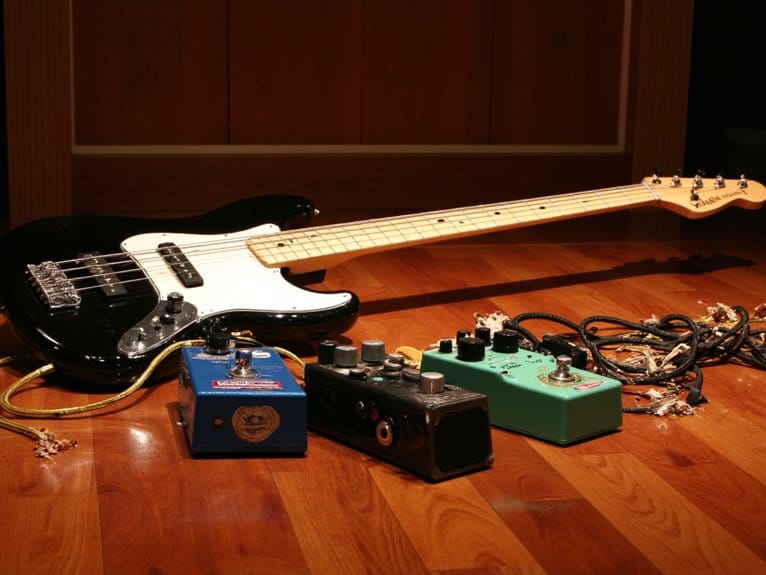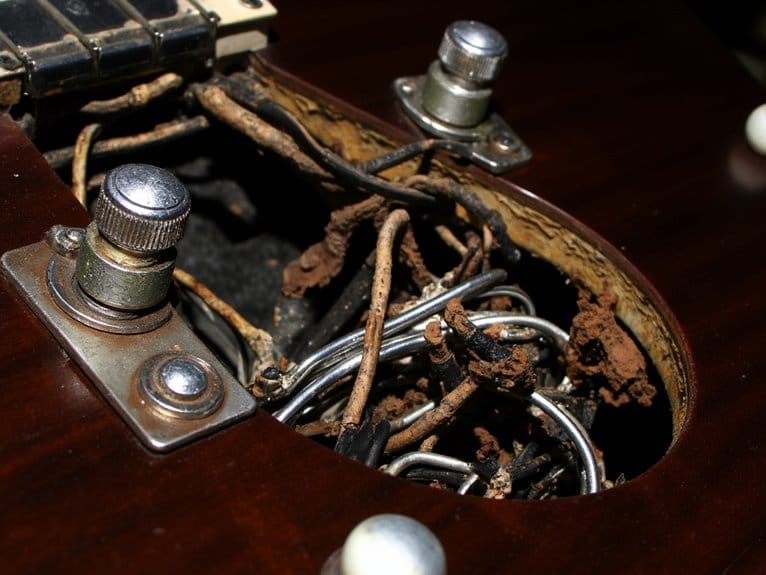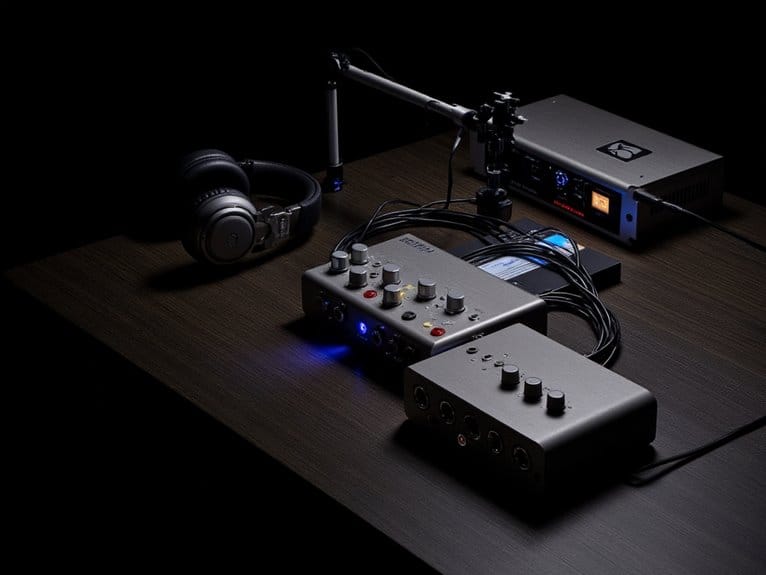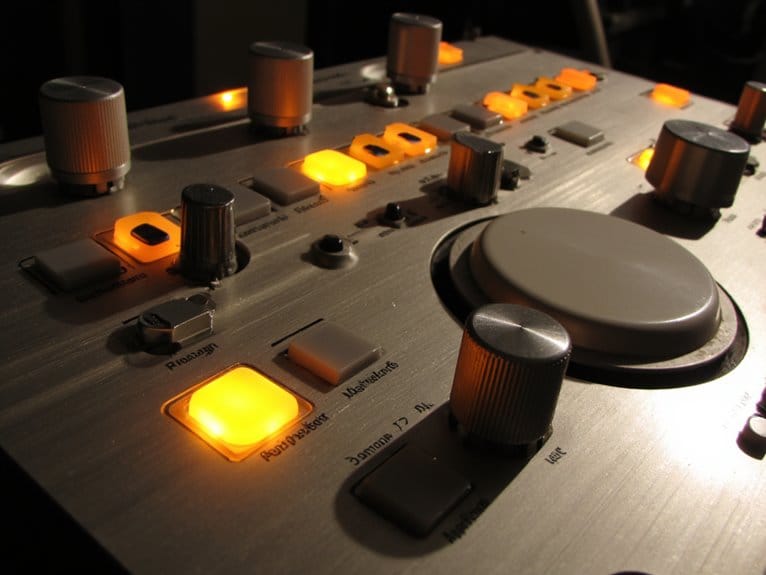Effects for Bass: What Works and What Doesn’t
You’ll find that compression, EQ, and overdrive form the essential foundation for bass effects, with compression evening out volume inconsistencies while preserving your low-end punch. Distortion and overdrive add grit through careful blending of clean and processed signals, while modulation effects like chorus and flanger create texture without muddying your tone. Bass-specific pedals work better than guitar variants since they’re designed to preserve those vital low frequencies that define your sound, and exploring the nuances of each category reveals countless sonic possibilities.
We are supported by our audience. When you purchase through links on our site, we may earn an affiliate commission, at no extra cost for you. Learn more.
Notable Insights
- Compression works exceptionally well for bass, evening out volume inconsistencies and enhancing sustain for professional-sounding bass lines.
- Bass-specific distortion and overdrive pedals preserve low frequencies better than guitar pedals, maintaining punch while adding desired grit.
- EQ and preamp pedals are essential tools that boost presence, eliminate muddy frequencies, and ensure proper mix placement.
- Modulation effects like chorus and envelope filters work well when used subtly, but heavy modulation can muddy the low-end.
- Octave and synth pedals expand tonal possibilities effectively when blend controls maintain the fundamental low frequencies underneath processed signals.
Essential Effects That Enhance Bass Performance
While I’ve spent countless hours tweaking knobs and chasing that perfect bass tone, I’ve learned that certain effects aren’t just luxuries-they’re essential tools that can transform your playing from serviceable to sublime.
Compression techniques form the foundation of professional bass sound, evening out volume inconsistencies while enhancing sustain and clarity that helps you cut through dense mixes. You’ll find that compressors make quiet notes audible and tame aggressive peaks, creating the consistent output that defines punchy, articulate bass tones.
Compression isn’t just an effect-it’s the secret weapon that transforms inconsistent playing into professional, punchy bass lines that cut through any mix.
For tonal shaping, EQ pedals become indispensable, allowing you to boost presence or eliminate muddy frequencies that compete with guitars and keyboards. Many professional bassists rely on dual-channel preamps that offer both clean tones and aggressive distortion capabilities for maximum versatility across different musical styles.
High-quality bass preamps with comprehensive 3-band EQ controls and proper DI outputs can serve as the cornerstone of your effects chain, providing the signal conditioning needed for both live performances and studio recording sessions. These preamps allow bassists to shape their sound more effectively, enhancing clarity and producing a richer tonal palette. When considering your setup, it’s essential to understand the differences between active tone vs passive tone, as this can significantly influence your overall sound and performance. Ultimately, the right preamp not only amplifies your signal but also transforms your bass’s character to suit various musical styles.
These fundamental effects maintain your bass’s natural character while ensuring it sits perfectly in any musical context.
Distortion and Overdrive: Adding Grit Without Losing Clarity
After mastering compression and EQ fundamentals, you’ll inevitably want to explore how distortion and overdrive can add character to your bass without sacrificing the low-end punch that defines your role in the mix.
Understanding overdrive characteristics helps you achieve warm tube-amp saturation through soft clipping, which gradually compresses peaks while preserving natural dynamics and clarity.
In distortion comparison, you’ll notice harder clipping creates more aggressive, sustained tones that cut through dense arrangements but compress dynamics considerably.
Bass-specific pedals maintain essential low frequencies better than guitar-oriented options, which tend to narrow frequency response and muffle sub-bass content. For bassists seeking optimal tone, using pedals specifically designed for bass guitars can enhance clarity and depth in performance. Additionally, pairing these pedals with the best short scale bass guitars can yield a rich, full-bodied sound that suits various musical styles. This combination allows players to fully exploit the unique capabilities of their instrument while preserving the integrity of the low end.
Blending clean and processed signals through parallel outputs or pedal controls preserves punch while adding desired grit, preventing the muddiness that often accompanies excessive drive levels.
Modulation and Time-Based Effects: Creating Texture and Space
Once you’ve explored distortion’s ability to add character, modulation and time-based effects open up entirely new dimensions for your bass playing, creating spatial depth and textural complexity that can transform simple lines into mesmerizing sonic landscapes.
| Effect | Primary Function |
|---|---|
| Chorus | Subtle delay with LFO modulation for thickness |
| Flanger | Short delays with pitch variation for sweeping |
| Phaser | Signal delay without pitch change for cyclic sweeps |
| Delay | Signal repetitions with adjustable timing |
| Octave/Pitch | Frequency shifting for expanded range |
Layering Techniques become essential when combining these effects, as each adds distinct harmonic content that can either complement or clash with your original signal. Delay Timing particularly matters-syncing to tempo creates rhythmic complexity, while ambient settings enhance spatial presence without overwhelming your fundamental tone.
Specialty Pedals and Creative Sound Shaping Tools
Beyond conventional effects lies a fascinating domain of specialty pedals that can fundamentally transform your bass from a traditional rhythm instrument into something approaching sonic alchemy.
Here, envelope filters respond to your touch dynamics, octave pedals add synthesizer-like textures, and advanced EQ tools sculpt frequencies with surgical precision. Synth pedals convert your signal into thick, resonant analog tones that’ll make you question whether you’re still playing bass, while octave versatility doubles your signal above or below for enhanced solo presence.
Envelope dynamics create funky auto-wah sweeps responding to your playing intensity, and wah expression adds vocal-like qualities through rocker control.
These “fine china” effects require selective use-you’ll want blend controls to maintain low-end fundamentals while exploring new sonic territories.
On a final note
You’ve got the roadmap now-distortion that maintains your low-end punch, modulation effects that add dimension without muddying your mix, and specialty pedals that’ll push your creativity forward. I’ve found that less is often more with bass effects; you don’t need every pedal on the market. Focus on quality over quantity, trust your ears over hype, and remember that your tone should always serve the song, not overshadow it. Experimenting with different combinations can yield surprising results, so don’t hesitate to try new setups. When searching for the best overdrive pedal, consider how it interacts with your existing effects to maintain clarity while enhancing your sound. Ultimately, your goal is to create a cohesive tone that elevates your performance and complements the music.






